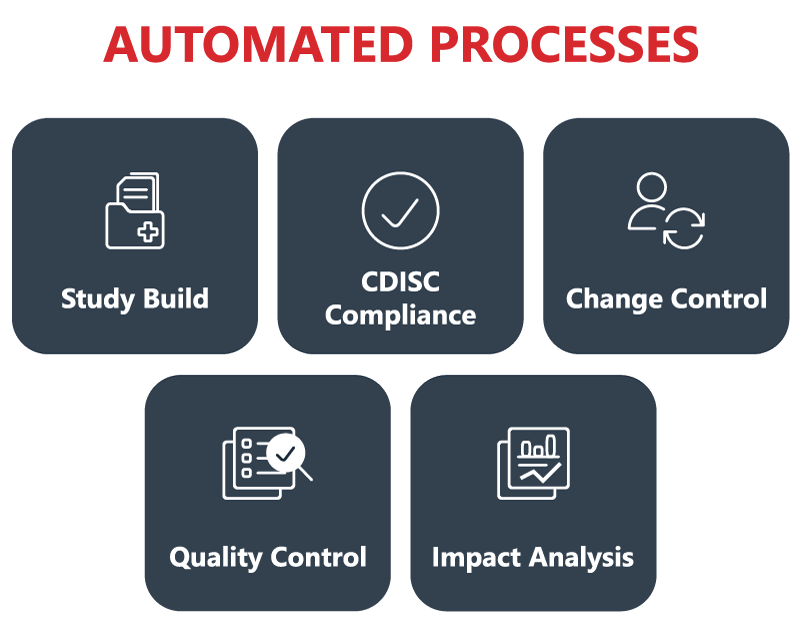When it comes to efficient clinical study build, content is king. Most importantly: metadata content. Metadata is the building blocks of your study. It’s the forms, terminologies and datasets you need to structure your study and start collecting data.
Managing clinical trial metadata can be challenging. You have to find the right content, make sure it’s compliant with CDISC standards, and get it approved before you start collecting data.
That’s where automated metadata management comes in. Automation can help streamline your clinical trial process, meaning more efficient study build and faster submission.
In this blog, we’ll explore the role of metadata in clinical trials, the benefits of automating metadata management, and how to implement standardization to help you build trials more quickly and efficiently.
What is metadata and why is it important for clinical trials?
The number of global clinical trials is increasing every year and there are more regulations than ever before. This means trials are becoming increasingly complex to manage. There’s a vast amount of data to be collected, organized and analyzed. Study teams must consider not only the study data, but the metadata too.
Metadata is often described as ‘data about data’. In other words, it gives detail and context to data elements. By doing so, it helps to organize and optimize data and makes it easier to use. Some examples of clinical metadata are case report forms (CRFs), datasets, controlled terminologies, mappings, and edit checks.
Metadata is a crucial part of any clinical trial. The FDA has made it mandatory for submissions to comply with CDISC standards – SDTM, ADaM, and Define-XML. Not only must the study submission comply with these standards, it must also include information describing the submitted data. Study metadata lets regulatory reviewers understand and interpret clinical trial data. The higher the quality the metadata, the quicker it is to review.
Common challenges in clinical metadata management
Many organizations use manual processes, such as Excel spreadsheets and Word documents, to manage metadata. Here are challenges of doing it this way:
- Inconsistency and errors: Manual metadata management means time consuming and fiddly work. For example, tracking changes to standards within a Word document or Excel spreadsheet can easily get confusing. And changes happen all the time in clinical studies! A manual process can be error-prone, leading to inaccurate and incomplete metadata.
- Lack of visibility and control over change: It’s not easy to see the impact of changes to your metadata when it’s stored manually in disparate places. It’s difficult to make decisions when you can’t see how other assets, standards, and the relationships between them are affected. You can’t see what may need to be changed as a result. If there’s no proper governance in place, metadata can become inconsistent, out of date, and inaccurate.
- Lack of standardization: Without standardization, metadata can be difficult to use and maintain. Staying up to date with changes to CDISC standards and knowing all the different versions is very tricky and time-consuming to do manually.
- Difficulty finding metadata: Metadata that is managed manually tends to be stored in different folders, on different systems, owned by different stakeholders, in different formats. Tracking it down wastes a lot of time and delays study build.
- Creating content from scratch for each study: Many organizations need to create metadata content from scratch every time, or dust off old content and review it before they can use it. This means the time to set up the study is longer than it needs to be.
- Difficult to manage and scale: Manual metadata management can be difficult to scale, especially when managing large volumes of data. For example, if you need to use different electronic data capture (EDC) systems and therefore different forms for different stages of your study, you need to be able to effectively manage the different versions and changes to them, to ensure accuracy and consistency.
Implementing automated metadata management in your organization
To stay ahead of the competition, clinical trial organizations are increasingly embracing technology solutions to help them effectively manage and automate metadata processes.
Implementing automated metadata management for your clinical trial requires careful planning and execution. The process can broadly be broken down into two phases, which we’ve explored below. Note, there isn’t necessarily a right or wrong order regarding how to implement automated metadata management, and you might run both phases in tandem. It all depends on what works best for your organization.
Phase 1: Implement a clinical metadata repository (CMDR)
Metadata management is done best when using a CMDR. A CMDR is a centralized repository for storing and governing clinical metadata. It has a user-friendly interface that allows planning, communication, and collaborative working between different teams. All your metadata is kept in one place, so it’s available for all stakeholders to easily find, edit, and share. Standards and automated processes are built into its framework to streamline clinical studies from inception to completion.
A CMDR allows organizations to connect disparate metadata siloes often present in clinical trial design. For example, different teams using different metadata, which is stored in various places, often resulting in inconsistencies and poor version control.
Typically, this phase might involve the following activities:
- Choosing a clinical metadata repository that meets your organization’s needs.
Uploading your metadata into the CMDR, or as with some systems, design metadata within the platform.
- Developing a metadata management and review strategy outlining how metadata will be maintained, including how to handle changes to metadata, retiring metadata and creating new metadata.
- Training employees on how to use the platform and following the metadata management strategy – CMDRs often come with training and are typically straightforward to use.
Phase 2: Standardize clinical metadata
This means creating metadata (forms, standards, annotations etc) that meets the requirements of the organization and getting these approved internally by all stakeholders. Once a metadata asset has passed quality checks, it is stored within the CMDR for use and reuse across studies.
Standardizing metadata reduces the resources, effort, and time spent setting up studies. Metadata is more consistent, higher quality, and the likelihood of a successful submission is increased.
Standardizing content also saves time that you’d otherwise be spending searching for the right forms, terminologies and annotations to use.
Typically, this phase might involve the following activities:
- Identifying the metadata commonly used throughout your clinical trials (eg case report forms).
- Standardizing the metadata in accordance with organizational needs, sponsor and regulatory requirements (eg aligning with controlled terminology).
- Getting all metadata reviewed and approved by relevant internal stakeholders, to make sure all department needs are met.
Don’t be put off by the steps above or the efforts required to create, implement and maintain a CMDR. Remember – the time you put into learning the new platform will pay dividends in the future because your clinical trials will become much faster and easier to build with automated metadata management in place.
For more information, read our blog: 临床元数据存储库应该做些什么?
How automated metadata management actually works
A CMDR and automation go hand-in-hand:
Automatic study build
A study can be built automatically from existing standards – there’s no need to manually look for content. You’ll only need to create new content when the specific study requires it.
Automatic compliance
Because content is standardized in alignment with regulatory standards, as well as sponsor-driven standards, studies are automatically compliant with CDISC. For example, controlled terminology (a form of metadata) is used to ensure consistency across trials. This means regulatory bodies can quickly locate, view, and analyze data, making the review process much more straightforward.
Automatic change control
Changes are automatically entered into a thorough approvals cycle, and tracked before being accepted. Meaning there’s no need for a complex manual cycle, with long email trails detailing changes, or potential version confusion.
Automatic impact analysis
The upstream or downstream impact of changes to standards is automatically identified – there’s no need to track this manually. You can review metadata adjustments (for example standards updates) and perform an impact analysis on all parts of the trial and connected studies before changes are approved and implemented.
Automatic quality control
Quality control is enforced through a customizable metadata lifecycle, meaning all stakeholders can see exactly which state a standard or study is in (i.e. draft, in progress, in review or approved) and only perform the actions allowed at that stage.
CMDRs facilitate automated metadata management, meaning clinical trial efficiencies and lasting changes to your study build process. In fact, we believe a CMDR could be one of the best investments a sponsor organization could make. In the next section, we take a look at some of the key benefits of automated metadata management.

The benefits of end-to-end automated metadata management
Automated metadata management offers many benefits over manual management.
- It saves time and reduces errors. Manual metadata management means human involvement in fiddly, time-consuming tasks. This can take up a lot of resources in the study build team, especially when dealing with large or multiple studies. By automating processes, organizations can save time and reduce the risk of human error.
- Metadata can be reused again and again. Metadata is only useful if it is accurate and consistent. Automated metadata management ensures that studies are built on the latest approved standards, so they can be reused. This in turn reduces the chance of errors, achieves consistency, whilst also saving time and effort.
- Stronger, more consistent, end-to-end processes. Each stage in a CMDR is built with the next stage in mind. Standards such as SDTM, ADaM, and Define are integrated into the framework. This allows for seamless automation and inheritance between the different stages. For example, generating database specifications from form designs or creating define.xml as you go rather than waiting for the study to complete.
- Improved searchability and discoverability. Metadata is created, edited, approved and retired within your CMDR. Everything is in one place, so you have peace of mind you’ll find what you need, when you need it.
- Visualize up front. Some CMDRs also let you design and preview eCRFs before your EDC is created. This ensures that it works just the way it should before you’ve even started collecting study data. This right-first-time approach removes the need for timely, repetitive approvals cycles and changes down the line.
The future of clinical metadata management
Building an effective clinical trial starts with metadata. With quality, standardized and approved metadata in place, trials can start faster and with less manual work. Insights can be gained earlier, and the trial can proceed more quickly.
Implementing a CMDR with automated metadata management can deliver many long-term benefits. As CDISC standards continue to be updated, and more and more regulations come into play, CMDRs will play a central role in organizing and standardizing this data to speed up the clinical trial process and make life easier for organizations. With clinical metadata standardized, organized and automated processes in place, organizations can focus on getting treatments to market more quickly.
Want to hear how one global biopharmaceutical company implemented automated metadata management? Read the case study “Dreaming big with standardization in clinical trial design – one biopharma’s metadata automation journey“.
What you should consider when selecting and implementing a Clinical MDR
Before selecting a clinical metadata repository, there are some key factors you should consider, in order to achieve a successful implementation. Our quick guide provides a 3-step best practice approach to start you off on the right path.




